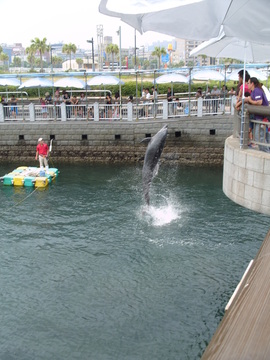 Blogging from Tokyo Narita International Airport. So, with IAVCEI finished, people are dispersing back home, on holidays, post conference field-trips or field-work. Myself I am travelling home. The last few days of the conference were certainly valuable with some great talks on Open Vent volcanoes such as Erebus and some fantastic posters to discuss. It was certainly good to hear all about others using Ultra-Violet cameras and what they are up to. On the last day, I had a few hours before my flight, so, back to Sakurajima...why not! On the way, some dolphin activity in a little canal leading from the aquarium. Hiking up a hill just outside the ferry port on Sakurajima side to a dinosaur park to look at the view of Kagoshima and of course the dinosaur! I do love a good submarine movie so when I see one I have to get as close as possible to get a picture (this happened to by first!) and when you zoom in on the photo apparently a submariner is trying to enjoy the view of the volcano. I am quite sure that is the direction he was looking, but it was quite cloudy so I'm not sure he saw a lot! Final reflections, a well organised conference, very valuable, I hope to see many of you again on future travels! 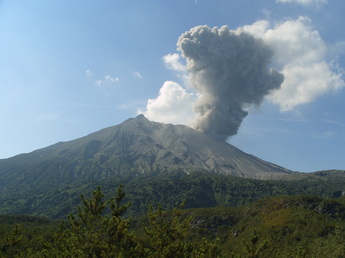 At a conference with many volcanologists, what's the best thing that could happen, free beer on a boat? Well yes that happened. Fireworks just for our enjoyment? Well, yes, that happened too. So what you ask...well, an eruption of Sakurajima would suffice I suppose, and WOW it was timed well (for me and others). The activity lasted for more than an hour an consisted of quite a few (around 10ish) individual explosions, the largest of which reached approximately 3 km in height (verified by someone from the Sakurajima observatory). Not only that, there was at least 3 occurrences of visible volcanic lightning. The photo on the right shows the beginning of the eruption, when I eventually trawl through my photos, I hope to find the lightning activity present, fingers crossed! I do have many many photos/videos that I will sort through and post when I can. Weirdly, the very start of the eruption was caught in a photo of me and the volcano (below right), you can just see it as a bump on the right hand slope (just) - thanks Michelle - Vancouver University IAVCEI participant! 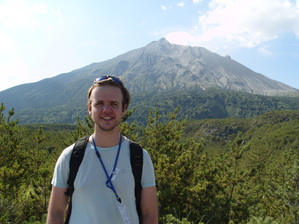 Small, bump on right of centre, the eruption start! Small, bump on right of centre, the eruption start! However, the day did not just consist of an eruption of Sakurajima, although that was certainly a very important part! A visit to an archaeological dig showed the inhabitants of the area around 9000 years ago, whilst a visit to the shrine was most illuminating. Although I (and I am sure others) were worried about getting the order of actions wrong - approach the entrance, throw a coin in, bow twice, clap twice, then bow again. I think that;s correct...I have to say how excellently organised the whole event was, well done Kagoshima and IAVCEI. All in all an excellent day topped off with my first experience of Japanese karaoke...great fun but very different. Now back in the hotel room (after getting a little lost on the way back - don't know how it happened). Good night all.  Japanese volcano entertainment! Japanese volcano entertainment! Day 2, another good day started off by a look at the occurrence and possible reasons for volcanic lightning, a look at cyclic activity at Santiaguito and the recent Taupo 2008 unrest. Heading in to my own section, some great discussions were had on my poster, so thanks all for comments. It is fantastic coming to events such as these when you come from such a small volcanology department (there are certainly benefits to this as well though!). Controversy in the CO2 section, what is the true value of global volcanic CO2 emissions? What is the error? Apparently estimations keep growing, now there are very significant variations in peoples estimates. It was also good to hear from experiences of others at the IAVCEI Early Career meeting - major lesson learnt - sometimes success is just luck! Visiting the back streets of Kagoshima with two friendly Americans, one from Cambridge Uni and the other from New Mexico Tech. We found a great restaurant on the 2nd floor with the below menu (all in Japanese - we're in trouble you say! Wrong! As luck would have it, New Mexico Tech used to live in Japan and new some of the writing. So after a lot of deliberation we decided on what we thought were Satsumas, Soba noodles and something called "children of the trees with bacon". We ended up with fried sweet potatoes, a bacon salad, soba noodles and some chicken thing. It was the best meal I have had so far, and I received free postcards for my trouble, people here are so friendly. That's it for today, field trip tomorrow around Aira caldera (I think!), time to get some rest. 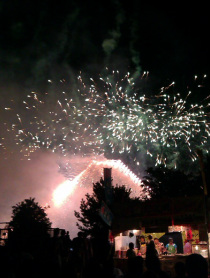 What an amazing first day, kicked off by an excellent talk by Barry Voight and representation in 2D and 3D of the 1980 Mt. St. Helens eruption. Followed by interesting talks on numerical and lab (well a quarry!) experiments by Ed Llewellin and a further high-speed imagery look at slug dynamics prior and during burst by Jacopo Taddeucci. To finish off the scientific session for the day, philosophical thoughts on simplicity in modelling and interesting overviews of Campi Flegrei (Italy) and White Island (New Zealand). Then, courtesy of IAVCEI two free boat tickets to get to Sakura-jima for the festival. Incredibly good fun, sitting on the grass watching some large drums played by somewhat smaller drummers and local dancing, whilst eating some amazing food (I wasn't brave enough to try fried Octopus). A great firework display which seemed to last for more than 30 minutes, with a superb sequence to finish with fireworks exploding above a firework volcano! My attempt at phone photography on the right, the town hall below and Sakurajima also below - a little bit hazy, and no explosion this time...I managed to see an aftermath of an explosion yesterday (drifting ashy plume), fingers crossed for a complete look at one. Oh and another experience, bouncing cars...I have certainly never seen that one before! For me this is my first big conference and what an excellent experience it has been so far. Everyone is very friendly and it is great to meet amazing new people, listen to others work and of course talk about my own (poster tomorrow by the way session 3J)! Anyway must get to sleep, early start tomorrow.  A bison in the background amid steamy pool. A bison in the background amid steamy pool. Yes that's right I have visited possibly the most touristy volcano in the world, Yellowstone. It is certainly an awe-inspiring place and not just for volcanological reasons! We came in via the southern entrance of the park passing through Jackson Hole and then just as you go past the "Welcome to Grand Teton National Park" welcome sign on the left springs up a stunning mountain range - funnily enough the Grand Tetons! The jagged and icy peaks are quite spectacular. Continuing on you finally enter the park and there is a little stop called Lewis Lake (by Lewis Lake), which, using the park map, is just inside the Caldera Boundary. It is standing here that you get a sense of how large Yellowstone caldera is (purely because you can't see the whole thing!), something I have always known but haven't truly appreciated. Of course its also excellent to visit all the other well known spots; Old (not so) Faithful, Norris Geyser Basin, Mammoth Hot Springs and the Yellowstone Lake. In the most active spots the faint Sulphur/Hydrogen Sulphide smell was never far away, particularly at the Sulphur Cauldron, although I think Seltun in Iceland smelt slightly worse. 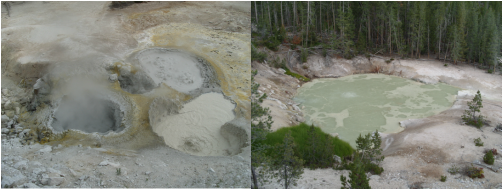 Left: Clear bubbling at Sulphur Cauldron and Right: The very acidic and yellow/green pond. Left: Clear bubbling at Sulphur Cauldron and Right: The very acidic and yellow/green pond. The Sulphur Cauldron is located in an area with high activity in the park and this area shows why - large amounts of Sulphur finding its way to the surface. Unfortunately it was tipping it down that afternoon so all my pictures look rather dull! It is fascinating to see a process occurring very rapidly, whereas the passive degassing I look at in magmatic systems will be significantly less vigorous (in most cases - the lava lake at Marum a clear exception). It would certainly be interesting to compare emission rates - I can never quite switch off! I was promised wildlife and I certainly got it, herds of bison (if it is a herd!), plenty of elk, black bears (times 3) and a chipmunk! I could babble on but I probably shouldn't.
Next time, and I am sure there will be a next time, it would be good to go "off the beaten track" I am sure there are many wonderful parts of the park, such as I have discovered in the Lake District (UK), that can only be accessed on foot. Note to self - must try and do future research in Yellowstone! 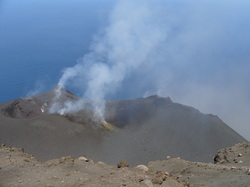 Why this post? Well, it is related to my own work which focuses on the passive degassing (see previous post for info) of basaltic magma, such as that at Stromboli and who doesn't love to talk about their own work! To the right is a still of the summit area and below is a video of this passive degassing in process. The visible part of the plume is mostly water vapour but also mixed with other such as sulphur dioxide and carbon dioxide. If you look closely at one of the smaller vents in the centre of the video below you can see a regular, but small, puffing, which is likely some form of atmospheric transport effect created by the small vent itself. This can also occur on a larger scale, and largely invisible to the naked eye. The summit of Stromboli is consistently throwing out these gases at a varying rate, it is part of my work to try and understand why and how this emission rate varies at volcanoes such as Stromboli and Etna. |
Archives
July 2023
|

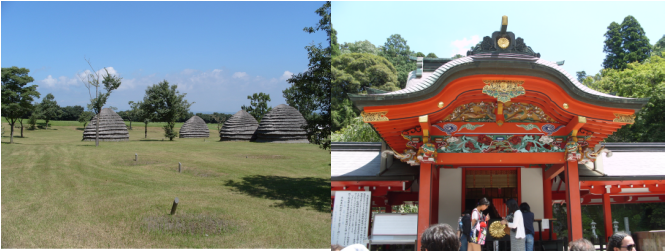
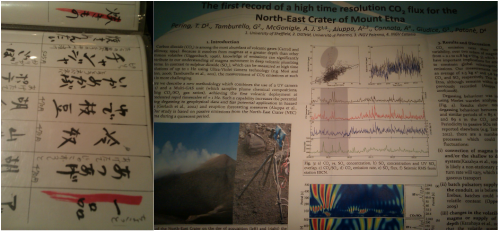

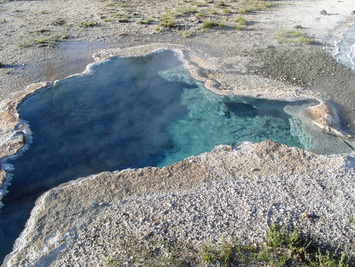

 RSS Feed
RSS Feed